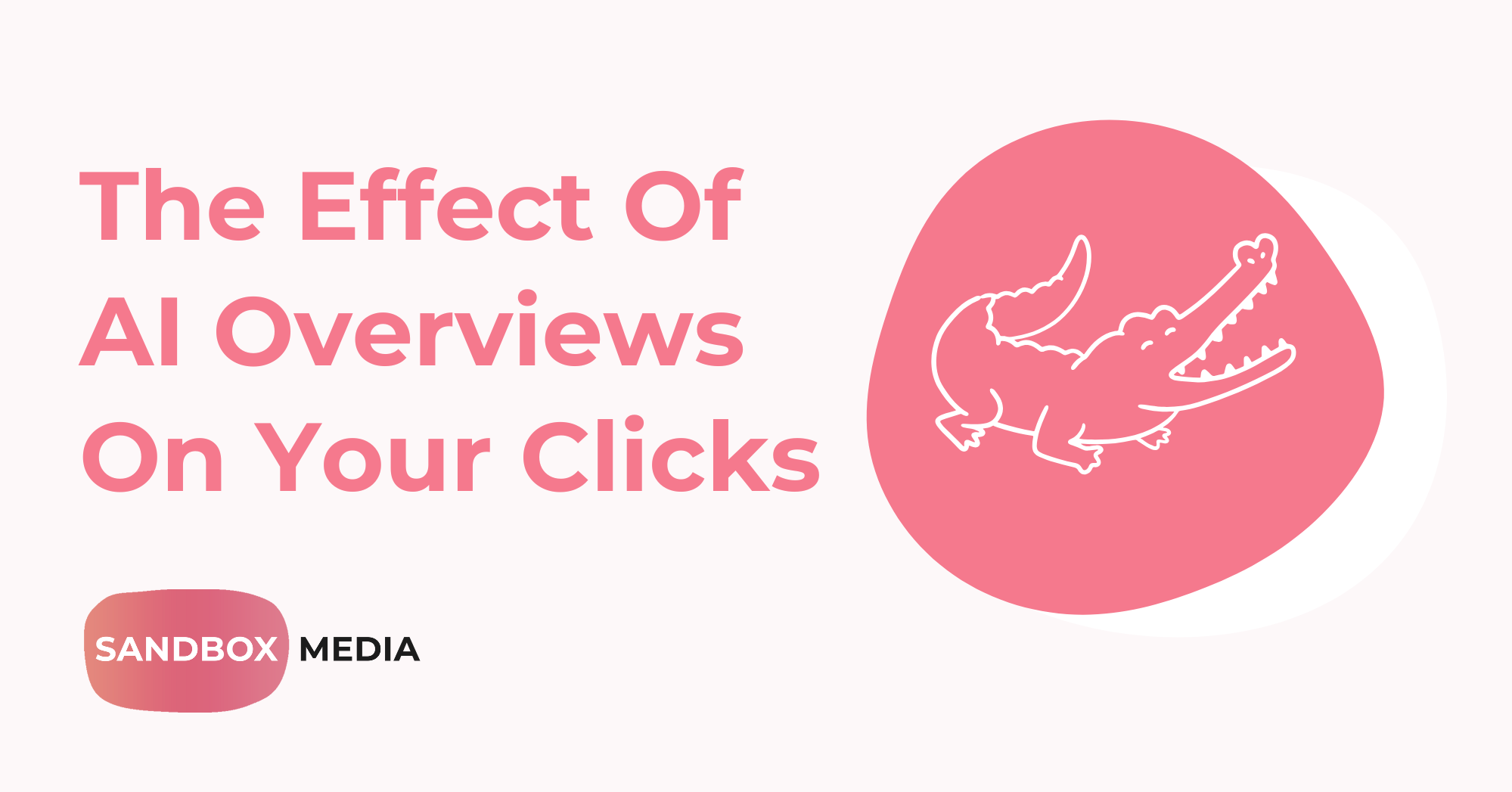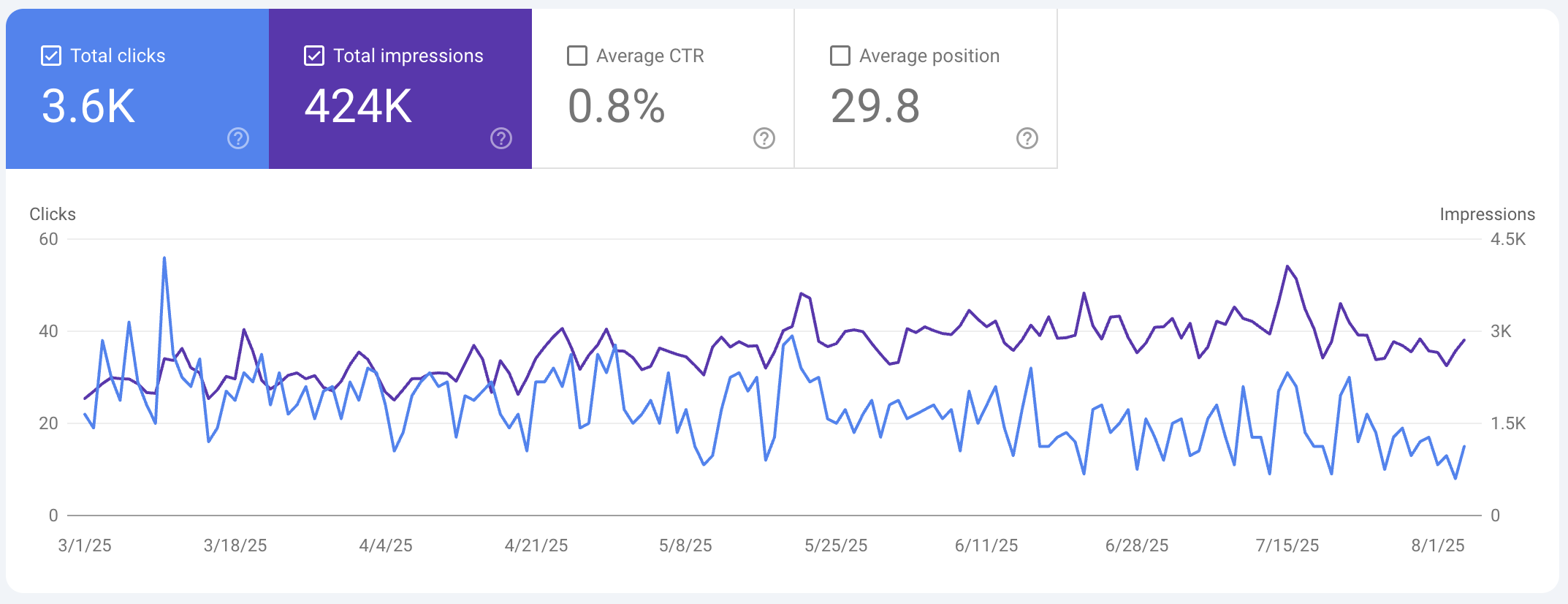Search is changing, and fast. If you’ve seen a drop in organic traffic despite maintaining high positions, you’re not imagining it.
Welcome to the era of AI Overviews, Google’s latest feature that displays summarised, AI-generated responses right at the top of the search results.
Great for users, but not so much for your clickthrough rate.
We’ve been closely monitoring this shift. “The Crocodile’s Mouth” refers to the growing gap between search impressions and clicks. In this article, we’ll discuss what this means for your business, why it’s happening, and, most importantly, what you can do about it.
Table of Contents
What does “The Crocodile’s Mouth” mean in SEO?
The term “Crocodile’s Mouth” describes the widening gap between search visibility and actual clicks caused by AI Overviews. Imagine a graph: impressions going up (top jaw), while your clickthrough rate goes down (bottom jaw). That sharp visual separation is what marketers are now up against.
Previously, ranking in the top three organic positions guaranteed a significant share of traffic. However, with AI Overviews increasingly dominating the above-the-fold space and summing content from multiple sources, even the top spot doesn’t hold the power it once did.
Businesses are losing traffic even though they are still ranking, largely because people no longer need to click through to get their answers. For many sites, the drop in traffic seems to come out of nowhere, unless you understand the new rules of the game.
The Reason Behind the Shift
In a recent study done by Ahrefs, analysing over 300,000 keywords, the data confirmed what many SEOs have feared: clickthrough rates drop by 34.5% when an AI Overview appears on the SERP.
That’s more than a third of your potential traffic gone, not because your content isn’t valuable, but because Google is now summarising it before the user even considers clicking.
Google’s AI Overviews are designed to reduce the friction between query and answer. Instead of clicking through multiple websites, users are presented with a clean, AI-generated summary sourced from content across the web, meaning they might never see your link at all.
From a user perspective, it’s awesome. From a business perspective, it’s disruptive. AI Overviews often cite sources, but that citation doesn’t guarantee a click. Sometimes, the overview borrows your hard-earned knowledge and leaves your brand name out of the conversation entirely. It’s a new type of zero-click search, and it’s fast becoming the norm.
This is much different to featured snippets, as they pull a direct quote or paragraph from a single web page and credit that source explicitly, often placing it in Position “0” with a clear link to your site.
Is the Crocodile’s Mouth a Sign of Bad SEO?
In short, no.
Seeing your traffic drop while impressions stay consistent doesn’t mean you’ve done anything wrong. It’s often a sign that your content is good enough to influence Google’s AI Overview, just not optimised to benefit from it.
This phenomenon highlights the difference between ranking well and performing well in AI-powered search. Traditional SEO might get your page seen, but Generative Engine Optimisation (GEO) is now what determines whether you get the click. If anything, the crocodile’s mouth is a signal to upgrade your SEO strategy, not abandon it.
Where Can I Spot This Crocodile’s Mouth in My Data?
The easiest place to see the Crocodile’s Mouth in action is within Google Search Console. Compare your site’s impressions and clicks on certain queries over time. If impressions remain high, or even grow, but clicks begin to fall for the same terms, you’re likely experiencing the effects of an AI Overview appearing in the SERPs.
Pay attention to:
- An abrupt drop in CTR on previously high-performing keywords/pages
- High-impression keywords with zero clicks
- Keywords triggering informational searches, questions, or list-based queries, as these are ideal candidates for AI Overviews
Pair this with tools like SERanking, Ahrefs or SEMrush to check if those keywords now display an AI box above the organic results.
The Impact on Your Business
A drop in traffic doesn’t just affect your vanity metrics; it directly impacts your bottom line.
Lower clicks may mean fewer leads, fewer sales, and less return on your SEO investment. And because AI Overviews favour content that’s structured, concise, and rich in topical authority, businesses without a focused content and technical strategy will fall behind.
The damage may be subtle at first, such as an increase in bounce rate or a drop in lead form submissions. But over time, the overall loss can be significant, especially if you rely on organic traffic as a primary source of leads. Ignoring the shift means missing out on opportunities your competitors will happily take.
How You Can Adapt Strategies for Zero-Click Search
To navigate the rise of AI Overviews and protect your traffic, businesses must evolve their SEO strategy toward Generative Engine Optimisation (GEO), optimising not just for rankings, but for inclusion in AI summaries.
Here’s how to do it successfully:
- Structure your content clearly: Use subheadings, bullet points, and straight-to-the-point answers to common questions. This increases the likelihood of your content being picked up by AI systems.
- Implement schema markup: This helps Google better understand your content contextually. FAQ, How-To, and Article schema are especially useful.
- Focus on E-E-A-T (Experience, Expertise, Authoritativeness, Trustworthiness): Create pages that showcase real-world expertise with named authors, credentials, and detailed explanations.
- Keep content up to date: Keep content rich in specific, verifiable information. AI Overviews favour fresh, authoritative answers.
- Target long-tail keywords and questions: These are more likely to trigger featured snippets and AI answers.
- Invest in off-page authority: This includes digital PR, editorial mentions, and link-building campaigns. Search engines favour domains that are widely referenced and cited, which directly boosts your chances of being included in AI-generated summaries.
AI Overviews are influenced not just by what’s on your site, but by how your brand is perceived across the web. Establishing external authority is now more important than ever.
How We Can Help You Adapt
We assist businesses in developing future-ready digital strategies that adapt to Google’s changing landscape, which includes the emergence of AI Overviews. Our Generative Engine Optimisation (GEO) services tailor your website’s content, structure, and authority to increase the likelihood of being featured in AI-generated results.
We’ll audit your current content and technical setup, identify opportunities to appear in AI Overviews and help implement structured content strategies that work for both humans and algorithms. But we don’t stop there.
We also help improve your off-page authority through link building, digital PR, and brand visibility campaigns, ensuring your domain is seen as a trustworthy source by search engines and their AI companions.
Final Thoughts
The crocodile’s mouth is open, but your business doesn’t have to be the one getting bitten. AI Overviews are here to stay, and they’re already changing how people discover and interact with material online. The key to surviving (and prospering) is to adapt early and strategically.
If your traffic graph is starting to look like a crocodile’s mouth, don’t wait until leads dry up. Get in touch with us today, and let’s build a strategy that puts your business back on top.
Glossary
Crocodile’s Mouth: A term used to describe the growing gap between high search impressions and declining clickthrough rates, particularly since the rise of AI Overviews. The graph of these two metrics together looks like a crocodile’s open jaws.
Zero Click Search: When users find the answer to their query directly in the search results (via AI Overviews, featured snippets, etc.) and don’t click through to any website. This can reduce traffic even when your site ranks well.
Vanity Metrics: Surface-level data like impressions, followers, or likes that look good on paper but don’t directly lead to business goals like conversions, leads, or sales.
AI Overview: A Google Search feature that uses generative AI to summarise answers from multiple sources directly in the search results, often reducing the need for users to click through to websites.
Generative Engine Optimisation (GEO): A modern SEO approach focused on tailoring content to be featured in AI-generated search summaries, like Google’s AI Overviews, by prioritising clarity, authority, and structured data.
Featured Snippet: A highlighted result at the top of Google Search that takes a direct answer from one web page, credited with a link.
E-E-A-T: An acronym for Experience, Expertise, Authoritativeness, and Trustworthiness, a set of content quality signals used by Google to assess whether a page is credible and worth ranking well.












